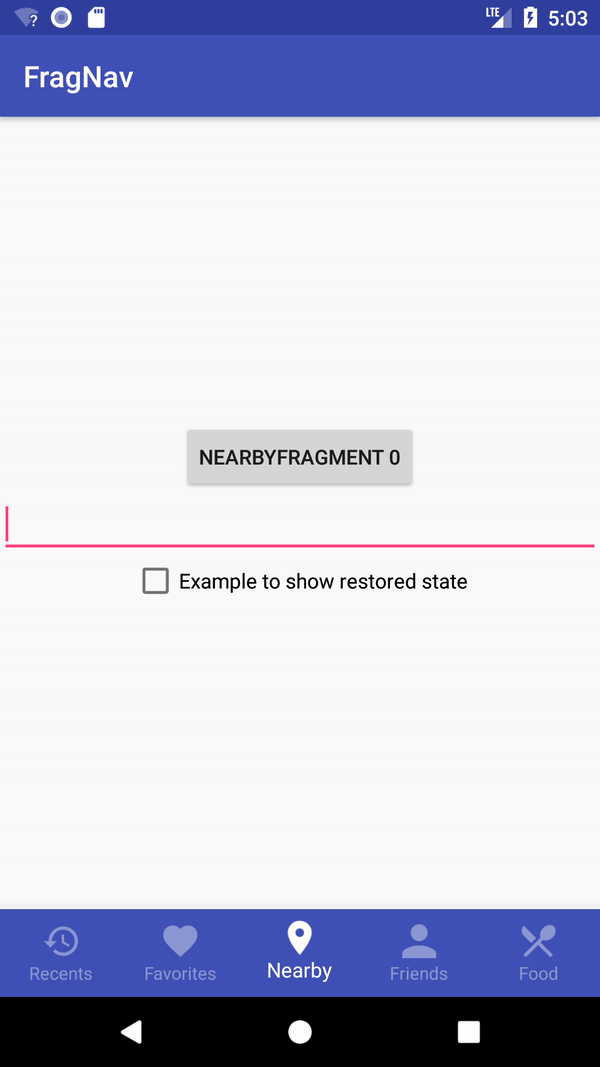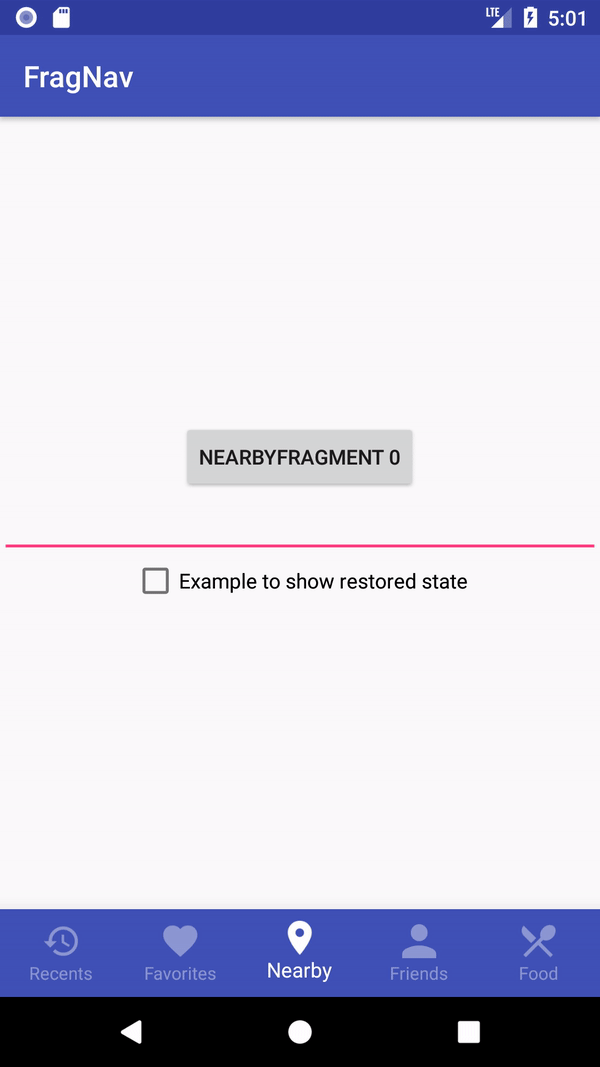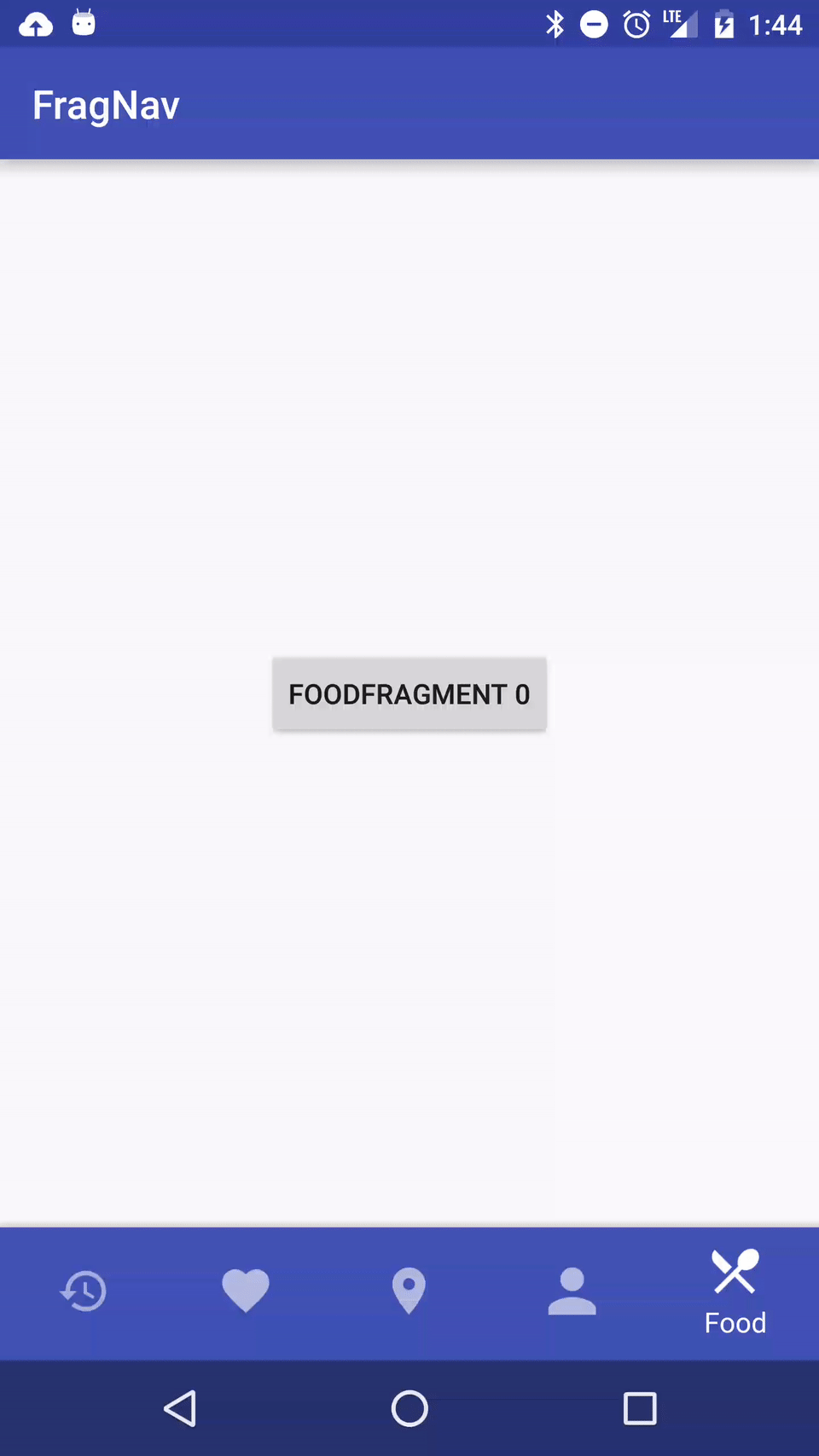Android library for managing multiple stacks of fragments (e.g., Bottom Navigation , Navigation Drawer). This library does NOT include the UI for bottom tab bar layout. For that, I recommend either BottomBar (which is the library shown in the demo) or AHBottomNavigation. This library helps maintain order after pushing onto and popping from multiple stacks(tabs). It also helps with switching between desired tabs and clearing the stacks.
With Material Design Bottom Navigation pattern, and other tabbed navigation, managing multiple stacks of fragments can be a real headache. The example file shows best practice for navigating deep within a tab stack.
implementation 'com.ncapdevi:frag-nav:2.4.0' //or or `compile` if on older gradle versionbuilder = FragNavController.newBuilder(savedInstanceState, getSupportFragmentManager(), R.id.container);Create a list of fragments and pass them in
List<Fragment> fragments = new ArrayList<>(5);
fragments.add(RecentsFragment.newInstance());
fragments.add(FavoritesFragment.newInstance());
fragments.add(NearbyFragment.newInstance());
fragments.add(FriendsFragment.newInstance());
fragments.add(FoodFragment.newInstance());
builder.rootFragments(fragments);Allow for dynamically creating the base class by implementing the NavListener in your class and overriding the getRootFragment method
public class YourActivity extends AppCompatActivity implements FragNavController.RootFragmentListener {builder.rootFragmentListener(this, 5) @Override
public Fragment getRootFragment(int index) {
switch (index) {
case INDEX_RECENTS:
return RecentsFragment.newInstance(0);
case INDEX_FAVORITES:
return FavoritesFragment.newInstance(0);
case INDEX_NEARBY:
return NearbyFragment.newInstance(0);
case INDEX_FRIENDS:
return FriendsFragment.newInstance(0);
case INDEX_FOOD:
return FoodFragment.newInstance(0);
}
throw new IllegalStateException("Need to send an index that we know");
}mFragNavController = builder.build();Send in the supportFragment Manager, a list of base fragments, the container that you'll be using to display fragments. After that, you have four main functions that you can use In your activity, you'll also want to override your onSaveInstanceState like so
@Override
protected void onSaveInstanceState(Bundle outState) {
super.onSaveInstanceState(outState);
if (mNavController != null) {
mNavController.onSaveInstanceState(outState);
}
}Tab switching is indexed to try to prevent you from sending in wrong indices. It also will throw an error if you try to switch to a tab you haven't defined a base fragment for.
fragNavController.switchTab(NavController.TAB1);You can only push onto the currently selected index
fragNavController.pushFragment(FoodFragment.newInstance())You can only pop from the currently selected index. This can throw an UnsupportedOperationException if trying to pop the root fragment
fragNavController.popFragment();You can pop multiple fragments at once, with the same rules as above applying. If the pop depth is deeper than possible, it will stop when it gets to the root fragment
fragNavController.popFragments(3);You can only replace onto the currently selected index
fragNavController.replaceFragment(Fragment fragment); fragNavController.clearStack(); showDialogFragment(dialogFragment);
clearDialogFragment();
getCurrentDialogFrag()All of the above transactions can also be done with defined transaction options. The FragNavTransactionOptions have a builder that can be used.
public class FragNavTransactionOptions {
List<Pair<View, String>> sharedElements;
@FragNavController.Transit
int transition = FragmentTransaction.TRANSIT_NONE;
@AnimRes
int enterAnimation = 0;
@AnimRes
int exitAnimation = 0;
@AnimRes
int popEnterAnimation = 0;
@AnimRes
int popExitAnimation = 0;
@StyleRes
int transitionStyle = 0;
String breadCrumbTitle;
String breadCrumbShortTitle;
} Have your activity implement FragNavController.TransactionListener and you will have methods that inform you of tab switches or fragment transactions
A sample application is in the repo if you need to see how it works.
Use FragNavController.setTransitionMode();
/**
* Get the number of fragment stacks
*
* @return the number of fragment stacks
*/
@CheckResult
public int getSize() {
return fragmentStacks.size();
}
/**
* Get a copy of the stack at a given index
*
* @return requested stack
*/
@SuppressWarnings("unchecked")
@CheckResult
@Nullable
public Stack<Fragment> getStack(@TabIndex int index) {
if (index == NO_TAB) {
return null;
}
if (index >= fragmentStacks.size()) {
throw new IndexOutOfBoundsException("Can't get an index that's larger than we've setup");
}
return (Stack<Fragment>) fragmentStacks.get(index).clone();
}
/**
* Get a copy of the current stack that is being displayed
*
* @return Current stack
*/
@SuppressWarnings("unchecked")
@CheckResult
@Nullable
public Stack<Fragment> getCurrentStack() {
return getStack(selectedTabIndex);
}
/**
* Get the index of the current stack that is being displayed
*
* @return Current stack index
*/
@CheckResult
@TabIndex
public int getCurrentStackIndex() {
return selectedTabIndex;
}
/**
* @return If true, you are at the bottom of the stack
* (Consider using replaceFragment if you need to change the root fragment for some reason)
* else you can popFragment as needed as your are not at the root
*/
@CheckResult
public boolean isRootFragment() {
Stack<Fragment> stack = getCurrentStack();
return stack == null || stack.size() == 1;
}
/**
* Helper function to get wether the fragmentManger has gone through a stateSave, if this is true, you probably want to commit allowing stateloss
*
* @return if fragmentManger isStateSaved
*/
public boolean isStateSaved() {
return fragmentManger.isStateSaved();
}
/**
* Use this if you need to make sure that pending transactions occur immediately. This call is safe to
* call as often as you want as there's a check to prevent multiple executePendingTransactions at once
*
*/
public void executePendingTransactions() {
if (!executingTransaction) {
executingTransaction = true;
fragmentManger.executePendingTransactions();
executingTransaction = false;
}
}
Fragments transitions in this library use attach()/detch() (http://daniel-codes.blogspot.com/2012/06/fragment-transactions-reference.html). This is a delibrate choice in order to maintain the fragment's lifecycle, as well as being optimal for memory. This means that fragments will go through their proper lifecycle https://developer.android.com/guide/components/fragments.html#Lifecycle . This lifecycle includes going through OnCreateView which means that if you want to maintain view states, that is outside the scope of this library, and is up to the indiviudal fragment. There are plenty of resources out there that will help you design your fragments in such a way that their view state can be restored https://inthecheesefactory.com/blog/fragment-state-saving-best-practices/en and there are libraries that can help restore other states https://github.com/frankiesardo/icepick
The reason behind this feature is that many of the "big" apps out there has a fairly similar approach for handling back navigation. When the user starts to tap the back button the current tab's fragments are being thrown away (FragNav default configuration does this too). The more interesting part comes when the user reaches the "root" fragment of the current tab. At this point there are several approaches that we can choose:
- Nothing happens on further back button taps - This is the default
- FragNav tracks "Tab History" and send a tab switch signal and we navigate back in history to the previous tab.
To use the history keeping mode you'll have to add extra parameters to the builder:
mNavController = FragNavController.newBuilder(...)
...
.switchController(FragNavTabHistoryController.UNLIMITED_TAB_HISTORY, new FragNavSwitchController() {
@Override
public void switchTab(int index, @Nullable FragNavTransactionOptions transactionOptions) {
bottomBar.selectTabAtPosition(index);
}
})
.build();Here first we have to choose between two flavors (see below for details), then we'll have to provide a callback that handles the tab switch trigger (This is required so that our UI element that also contain the state of the selected tab can update itself - aka switching the tabs always triggered by the application never by FragNav).
| UNLIMITED_TAB_HISTORY | UNIQUE_TAB_HISTORY |
|---|---|
 |
 |
While having a good architecture and caching most of the data that is presented on a page makes attaching / detaching the fragments when switching pretty seamless there may be some cases where even a small glitch or slowdown can be bothering for the user. Let's assume a virtualized list with couple of hundred items, even if the attach is pretty fast and the data is available rebuilding all the cell items for the list is not immediate and user might see some loading / white screen. To optimize the experience we introduced 3 different possibility:
-
Using attach and detach for both opening new fragments on the current stack and switching between tabs - This is the default - DETACH
-
Using attach and detach for opening new fragments on the current stack and using show and hide for switching between tabs - DETACH_ON_NAVIGATE_HIDE_ON_SWITCH
Having this setting we have a good balance between memory consumption and user experience. (we have at most as many fragment UI in the memory as the number of our tabs)
-
Using Fragment show and hide for both opening new fragments on the current stack and switching between tabs - HIDE
This gives the best performance keeping all fragments in the memory so we won't have to wait for the rebuilding of them. However with many tabs and deep navigation stacks this can lead easily to memory consumption issues.
WARNING - Keep in mind that using show and hide does not trigger the usual lifecycle events of the fragments so app developer has to manually take care of handling state which is usually done in the Fragment onPause/Stop and onResume/Start methods.
mNavController = FragNavController.newBuilder(...)
...
.fragmentHideStrategy(FragNavController.DETACH_ON_NAVIGATE_HIDE_ON_SWITCH)
.eager(true)
.build();There is also a possibility to automatically add and inflate all the root fragments right after creation (This makes sense only using HIDE and DETACH_ON_NAVIGATE_HIDE_ON_SWITCH modes). To have this you should set "eager" mode to true on the builder (Default is false).
Feel free to send me a pull request with your app and I'll link you here:
| Logo | Name | Play Store |
|---|---|---|
| Rockbot DJ |  |
|
| Rockbot Remote |  |
|
 |
Skyscanner |  |
 |
Fonic / Fonic Mobile |  |
If you have any problems, feel free to create an issue or pull request.
The sample app in the repository uses BottomBar library.
FragNav Android Fragment Navigation Library
Copyright (c) 2016 Nic Capdevila (http://github.com/ncapdevi).
Licensed under the Apache License, Version 2.0 (the "License");
you may not use this file except in compliance with the License.
You may obtain a copy of the License at
http://www.apache.org/licenses/LICENSE-2.0
Unless required by applicable law or agreed to in writing, software
distributed under the License is distributed on an "AS IS" BASIS,
WITHOUT WARRANTIES OR CONDITIONS OF ANY KIND, either express or implied.
See the License for the specific language governing permissions and
limitations under the License.
